

Digital Learning: What Kids Really Want. E-Learning | Research Digital Learning: What Kids Really Want By Chris Riedel According to Project Tomorrow CEO Julie Evans, "Today's students have their own 'student vision' for how they want to use technology for learning.
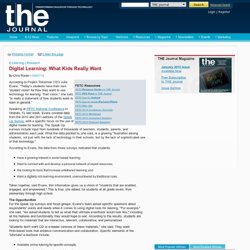
That vision," she said, "is really a statement of how students want to learn in general. " Speaking at FETC National Conference in Orlando, FL last week, Evans covered data from the 2010 and 2011 editions of the Speak Up Survey , with a specific focus on the use of digital media for learning. EDpuzzle Review: Easy-to-Use Tool Lets Teachers Quickly Turn Online Video into Lessons.
There is a staggering amount of free video available online that makes great fodder for teaching students, particularly in flipped classroom settings.
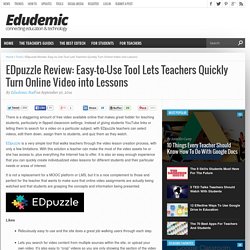
Instead of giving students YouTube links or telling them to search for a video on a particular subject, with EDpuzzle teachers can select videos, edit them down, assign them to students, and quiz them as they watch. EDpuzzle is a very simple tool that walks teachers through the video lesson creation process, with only a few limitations. With this solution a teacher can make the most of the video assets he or she has access to, plus everything the Internet has to offer. Transforming the Lecture Space. Why the flipped classroom? MIT study: "the least brain activity is evident when students watch television and are in class." Sal Khan’s ‘Academy’ sparks a tech revolution in education.
Salman Khan (credit: Khan Academy) Salman Khan’s simply narrated, faceless home videos on everything from algebra to French history have been viewed half a billion times.
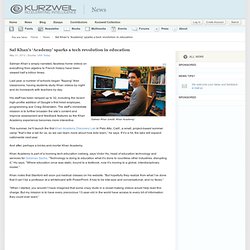
Last year, a number of schools began “flipping” their classrooms, having students study Khan videos by night and do homework with teachers by day. Flipped Classroom Infographic #flippedclassroom #blendedlearning #edtech. Flipping the Classroom. 4/27/2012 By: Teachers from around the world have adopted the flipped classroom model and are using it to teach a variety of courses to students of all ages.
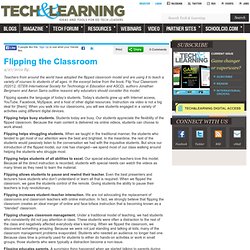
In the excerpt below from the book, Flip Your Classroom (©2012, ISTE® International Society for Technology in Education and ASCD), authors Jonathan Bergmann and Aaron Sams outline reasons why educators should consider this model. Why Khan Academy is so popular—and why teachers shouldn't feel threatened. Sal Khan’s nonprofit now contains more than 3,100 free video tutorials, mostly on math and science—but the site has begun expanding its scope to other subjects, too.
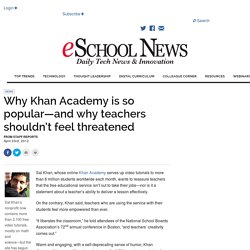
Sal Khan, whose online Khan Academy serves up video tutorials to more than 6 million students worldwide each month, wants to reassure teachers that the free educational service isn’t out to take their jobs—nor is it a statement about a teacher’s ability to deliver a lesson effectively. On the contrary, Khan said, teachers who are using the service with their students feel more empowered than ever.
“It liberates the classroom,” he told attendees of the National School Boards Association’s 72nd annual conference in Boston, “and teachers’ creativity comes out.” Flipteaching. ‘Flipped classroom’ teaching model gains an online community. Peer Instruction relies on the power of the "flipped classroom.
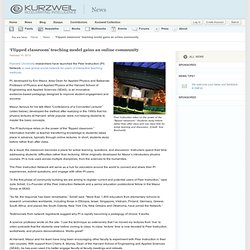
" Students study before rather than after class and use class time for active learning and discussion. (Credit: Sue Borchardt) Harvard University researchers have launched the Peer Instruction (PI) Network, a new global social network for users of interactive teaching methods. PI, developed by Eric Mazur, Area Dean for Applied Physics and Balkanski Professor of Physics and Applied Physics at the Harvard School of Engineering and Applied Sciences (SEAS), is an innovative evidence-based pedagogy designed to improve student engagement and success. Mazur, famous for his talk titled “Confessions of a Converted Lecturer” (video below), developed the method after realizing in the 1990s that his physics lectures at Harvard, while popular, were not helping students to master the basic concepts. How A Flipped Classroom Actually Works [Interview] What happens when the students have more control in the classroom? Flipped classrooms are being tested out around the world and we’ve featured a few examples in case you wanted to see who is flippin’ out.
Until now, we didn’t have an in-depth look at the effects of a flipped classroom or answers to the big questions it raises. Thanks to Susan Murphy of Algonquin College (check out her awesome blog suzemuse.com !) , we have our answers. She was kind enough to answer some of my questions about her experiences flipping her classroom. She used the flipped classroom model for her First Year Video and Audio Production class which is part of the Interactive Multimedia Developer program. What inspired you to use the flipped classroom model? One of the big challenges I was having in my video production class was teaching the required software (Adobe Premiere Pro). No more paper, no more books. 3/28/2012 By: Len Scrogan Digital content, streaming media, and on-demand learning resources are cascading into schools, replacing a tired generation of antiquated tools and practices.
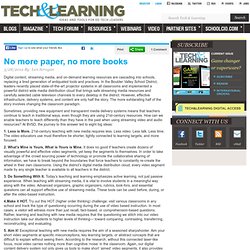
In the Boulder Valley School District, leaders recently placed state-of-the-art projector systems in all classrooms and implemented a powerful district wide media distribution cloud that brings safe streaming media resources and carefully selected cable television channels to every desktop in the district. However, effective infrastructure, delivery systems, and content are only half the story. The more exhilarating half of the story involves changing the classroom paradigm. Sometimes, providing new equipment and transparent media delivery systems means that teachers continue to teach in traditional ways, even though they are using 21st-century resources.